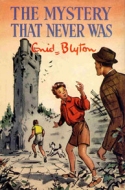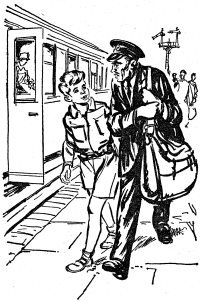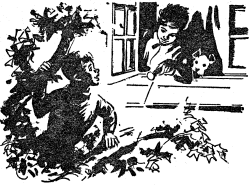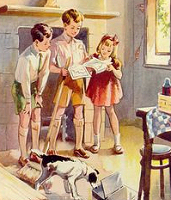
The Mystery That Never Was
Review by Keith Robinson (June 10, 2006)
The oddly-named short novel, The Mystery That Never Was, features a lively boy named Nicky Fraser and his next door neighbor and best friend, Ken. Nicky is a live wire, and his excitement is almost contagious as he begins the story rushing about the house on the first day of the Easter hols. What with him and his dog, Punch, you feel almost as worn out as the poor housekeeper during the first couple of chapters.
Nicky's Uncle Bob is coming to stay, and this is great cause for even more excitement—because Uncle Bob is a private detective! However, Mrs Fraser soon dampens Nicky's spirits by telling him that Uncle Bob is coming to stay for a well-earned rest due to overworking. That means, she tells her son, that Uncle Bob should be left alone to relax. Absolutely no excitement during his short stay!

Unfortunately Nicky is in such a rush to meet his uncle at the station that he fails to hear his mother telling him that Uncle Bob will be driving over! What follows is a case of "mistaken identity" very similar to the sort of thing the Find-Outers get mixed up in when trying to spot a disguised Fatty getting off the train.
With that little bit of excitement out of the way, things settle down and Mrs Fraser begins to worry about Nicky's uncle being bored. Rather than sit and mope all day, she says to Nicky, he really needs something to do—something to get his teeth into!
This sets Nicky thinking, and before long he and Ken (in Ken's shed next door) come up with a plan: They'll create some kind of mystery, involving flashing lights and strange notes, which they can somehow involve Uncle Bob in. It's Ken's idea, but Nicky runs with it and soon comes up with the details. He asks Ken to write a coded message of some sort, and meanwhile goes to find his uncle to see if he wants to go bird-watching up Skylark Hill. Uncle Bob is delighted to tag along, and they all set off up the hill.
At the top stands a ruined old house, once owned by a prince but burned down long ago. The whole place is blackened and dangerous, with only its single tower untouched by flames...

The boys are quite clever at "allowing" Uncle Bob to find the made-up note, and they put on quite a show of surprise when the note is read aloud. But Uncle Bob isn't quite as gullible as they hoped. He thinks it's some kind of school-boy prank. A little disheartened, the boys urge Uncle Bob to explore the old house anyway, and they dip into its cellars, which lead to underground passages. But the exporation is short-lived because Nicky's torch gives out.

As a reader I'm gleefully thinking to myself that either Uncle Bob is playing dumb and is planning to put on a show for the boys, or Nicky is going to take the fake mystery further himself. Or both! The potential for a horrible mix-up at this point of the story is enormous.

The boys don't consider that as a possibility, which enforces the concept in my head. So, thinking I've guessed the rest of the plot, I'm rubbing my hands in delight at what's to come.
But it turns out Uncle Bob is in his room! So now I'm wondering if perhaps he's using accomplices in his little scheme, to provide a first class mystery for the boys that he can share in. This seems a little elaborate, though, even for a private investigator—especially at such short notice. The story becomes even more puzzling when the boys and girls explore the hill the next day, and the boys are captured by "villains" in the act of digging around in the tunnels beneath the hill, looking for treasure! Still I'm thinking, "This MUST be Uncle Bob's doing—after all, the note mentioned signalling, and sure enough there was signalling; the note also mentioned meeting in the cellars, and stuff that is hidden there—and here these men are, digging around in the cellars! And, most telling, the note mentions a man named Harry—and here he is, a man named Harry, the boss of the other two villains! It HAS to be Uncle Bob playing a trick on the boys.
But when the men start getting rough, I start doubting. And at the same time I start thinking, "Please don't let this all be an incredible coincidence, a made-up mystery come true!"

I wanted this to have a different ending. The Mystery That Never Was really should have stayed as a mystery that never was, instead of turning into a mystery that stretches credulity to the limit. A bit of a let down in the end.
And WHAT was the signalling about anyway? Some sort of plausible explanation for this would have been nice; it's not enough to have signalling just for the sake of it.
A rather queer book, this.


